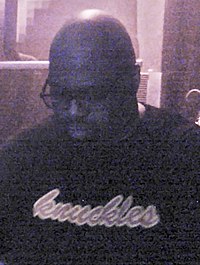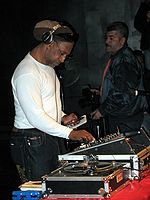MIXTAPE
| This article needs additional citations for verification. (October 2014) (Learn how and when to remove this template message) |
Essayist Geoffrey O'Brien has called the personal mix tape "the most widely practiced American art form".[2]
History
The most common early mix tapes were bootleg 8 track tapes that were sold at flea markets and truck stops in the late 1960s through the early 1980s, with names like "Super 73", "Country Chart Toppers" or "Top Pops 1977".[citation needed] Homemade mix tapes became common in the 1980s. Although the compact audio cassette by Philips appeared at the 1963 Berlin Radio Show,[3] the sound quality of cassettes was not good enough to be seriously considered for music recording until further advances in tape formulations, including the advent of chrome and metal tape. Before the introduction of the audio cassette, the creation of a pop music compilation required specialized or cumbersome equipment, such as a reel-to-reel or 8 track recorder, that was often inaccessible to the casual music fan. As cassette tapes and recorders grew in popularity and portability, these technological hurdles were lowered to the point where the only resources required to create a mix were a handful of cassettes and a cassette recorder connected to a source of pre-recorded music, such as a radio or LP player. The 8-track tape cartridge was more popular for music recording during much of the 1960s, as the cassette was originally only mono and intended for vocal recordings only, such as in office dictation machines. But improvements in fidelity finally allowed the cassette to become a major player. The ready availability of the cassette and higher quality home recording decks to serve the casual home user allowed the cassette to become the dominant tape format, to the point that the 8 track tape nearly disappeared shortly after the turn of the 1980s. The growth of the mixtape was also encouraged by improved quality and increased popularity of audio cassette players in car entertainment systems, and by the introduction of the Sony Walkman in 1979.A distinction should be drawn between a private mixtape, which is usually intended for a specific listener or private social event, and a public mixtape, or "party tape", usually consisting of a recording of a club performance by a DJ and intended to be sold to multiple individuals. In the 1970s, such DJs as Grandmaster Flash and the Furious Five, Afrika Bambaataa and the Soulsonic Force, Kool Herc and the Herculoids, and DJ Hollywood would often distribute recordings of their club performances via audio cassette, as well as customized recordings (often prepared at exorbitant prices) for individual tape purchasers. These recordings tended to be of higher technical ability than home-made mixtapes and incorporated techniques such as beatmatching and scratching. One 12 October 1974 article in Billboard Magazine reported, "Tapes were originally dubbed by jockeys to serve as standbys for times when they did not have disco turntables to hand. The tapes represent each jockey's concept of programming, placing, and sequencing of record sides. The music is heard without interruption. One- to three-hour programs bring anywhere from $30 to $75 per tape, mostly reel-to-reel, but increasingly on cartridge and cassette." Club proprietors, as well as DJs, would often prepare such tapes for sale.
Today, websites concerned with electronic music provide mixes in a digital format. These usually consist of recorded DJ sets of live, beat-matched mixes of songs, which are used by DJs seeking to demonstrate their mixing skills to an online audience. Some radio shows worldwide specialize in mix series, including The Breezeblock on BBC Radio 1, The Solid Steel Show (formerly on KISS-FM), and Eddy Temple-Morris/The Remix on Xfm.
Additionally, DJs such as Grandmaster Flash, DJ QBert, DJ Spooky, DJ Z-Trip or DJ Shadow, The Avalanches, and Rjd2 have gained fame for creating new songs by combining fragments of existing songs (which need not necessarily belong to the same genre). The resulting remix or mash-up can be seen as an evolution of the mixtape, in that it appropriates existing songs to give them new meanings through their juxtaposition, but does so in a quicker, more integrated style. This practice is heavily derived from the use of song loops as musical backdrops for an MC's rhymes in hip hop music, which is also related to turntablism.
Aesthetic
While the process of recording a mix onto an audio cassette from LPs or compact discs is technically straightforward, many music fans who create more than one mixtape are eventually compelled to confront some of the practical and aesthetic challenges involved in the mixtape format. From a practical standpoint, such issues as avoiding an excessive amount of blank tape at the end of one side (which requires careful planning of the length of each side of the mix) and reducing the audible click between songs (which requires mastery of the pause button on the cassette recorder) have been identified as part of the shared experience of mixtape aficionados. From an aesthetic point of view, many enthusiasts believe that because a tape player, unlike a CD player, lacks the ability to skip from song to song, the mixtape needs to be considered in its entirety. This requires the mixtape creator to consider the transitions between songs, the effects caused by juxtaposing a soft song with a loud song, and the overall "narrative arc" of the entire tape. One notable listing of such aesthetic "rules" can be found in a paragraph from Nick Hornby's High Fidelity:| “ | To me, making a tape is like writing a letter—there's a lot of erasing and rethinking and starting again. A good compilation tape, like breaking up, is hard to do. You've got to kick off with a corker, to hold the attention (I started with "Got to Get You Off My Mind", but then realized that she might not get any further than track one, side one if I delivered what she wanted straightaway, so I buried it in the middle of side two), and then you've got to up it a notch, or cool it a notch, and you can't have white music and black music together, unless the white music sounds like black music, and you can't have two tracks by the same artist side by side, unless you've done the whole thing in pairs and...oh, there are loads of rules. | ” |
From an artistic point of view, many creators of mix tapes seem to regard them as a form of emotional self-expression, although whether a mix tape retains the same web of emotional associations when passed from its creator to the recipient is, at best, debatable. Some argue that in selecting, juxtaposing, or even editing originally unrelated tracks of pop music into a new work of art, the "author" of a mix tape moves from passive listener to archivist, editor, and finally active participant in the process of musical creation. (Some legitimacy for this viewpoint was provided by Cassette Stories, a 2003 exhibition at the Museum of Communication in Hamburg, Germany, which featured stories and submissions from eighty mix tape enthusiasts.) However, this perception of the mix tape as a work of art has been criticized as resulting in a sort of elitism, with creators becoming more concerned with finding arcane and surprising combinations of tracks than with creating a tape that is listenable, enjoyable, or appropriate to its intended recipient. (In High Fidelity, for example, the narrator's girlfriend complains that his mix tapes are too didactic.) On a very basic level, the creation of a mix tape can be seen as an expression of the individual compiler's taste in music, often put forward for the implicit approval of the tape's recipient, and in many cases as a tentative step towards building the compiler's personal canon of pop music.























 06:37
06:37
 Unknown
Unknown

















